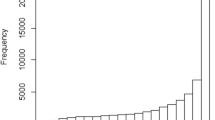Abstract
Fifteen pairs of children were matched on MLU. Members of each pair differed by 6 months or more in age. The younger (precocious) children's language was compared to the older (slower) children's on a number of complexity measures. Precocious children emphasized nouns more and tended to make more errors; slower children scored higher on a comprehension task. This suggests that there may be qualitatively different approaches to language development that relate to speed of language acquisition.
Similar content being viewed by others
References
Bates, E. (1979).The Emergence of Symbols, Academic Press, New York.
Bloom, L., Lightbown, P., and Hood, L. (1975).Structure and Variation in Child Language (Monograph of the Society for Research in Child Development, 160). University of Chicago Press, Chicago.
Bowerman, M. (1976). Semantic factors in the acquisition of rules for word use and sentence construction. In D. Morehead and H. Morehead (eds.),Directions in Normal and Deficient Child Language, University Park Press, Baltimore.
Brown, R. (1973).A First Language: The Early Stages, Harvard University Press, Cambridge.
Chapman, R., and Kohn, L. (1977). Comprehension strategies in two- and three-year-olds: Animate agents or probable events. Stanford University,Pap. Rep. Child Lang. Dev. 13:22–29.
Curtiss, S. (1977).Genie: A Psycholinguistic Study of a Modern-Day “Wild Child,” Academic Press, New York.
Horgan, D. (1975). Language development: A cross-methodological study. Doctoral dissertation, The University of Michigan.
Horgan, D. (1977). Individual differences in rate of language acquisition. Paper presented at Boston University Language Development Conference.
Horgan, D. (1978a). The development of the full passive.J. Child Lang. 5:65–80.
Horgan, D. (1978b). How to answer questions when you've got nothing to say.J. Child Lang. 5:159–165.
Horgan D. (1980a). The importance of word order: Differences between comprehension and production and differences between individuals. In B., Ketteman and R. E. St. Clair (eds.),New Approaches to Language Acquisition, Tübingen Beitrage Lingvistic, Germany.
Horgan, D. (1980b). Nouns: Love 'em or leave 'em. In. V. Teller and S. White,Studies in Child Language and Multilingualism, New York Academy of Sciences, New York, pp. 5–26.
Leonard, L., Bolders, J., and Miller, J. (1976). An examination of the semantic relations reflected in the language usage of normal and language disordered children.J. Speech Hear. Res. 19:371–392.
Limber, J. (1973). The genesis of complex sentences. In T. E. Moore (ed.),Cognitive Development and the Acquisition of Language, Academic Press, New York.
Macaulay, R. K. S. (1978). The myth of female superiority in language.J. Child Lang. 5:353–363.
Nelson, K. (1973).Structure and Strategy in Learning to Talk (Monographs of the Society for Research in Child Development, 149). University of Chicago Press, Chicago.
Nelson, K. (1975). The nominal shift in semantic-syntactic developmentCognit. Psychol. 7:461–479.
Nelson, K. (n.d.). Individual differences in language development: Implications for development and langage. Unpublished manuscript.
Peters, A. (1977). Language learning strategies: Does the whole equal the sum of the parts?Language 53(3):560–575.
Ramer, A. L. H. (1976). Syntactic styles in emerging language.J. Child Lang. 3:49–62.
Schachter, F. (1979).Everyday Mother Talk to Toddlers, Academic Press, New York.
Slobin, D. (1972). Children and Language: They learn the same way all around the world.Psychology Today, Vol. 6, No. 2, July. pp. 71–74 and 82.
Wolf, D., and Gardner, H. (1979). Style and sequence in symbolic play. In M. Franklin and N. Smith (eds.),Early Symbolization. Erlbaum, Hillsdale, N.J.
Author information
Authors and Affiliations
Rights and permissions
About this article
Cite this article
Horgan, D. Rate of language acquisition and noun emphasis. J Psycholinguist Res 10, 629–640 (1981). https://doi.org/10.1007/BF01067298
Issue Date:
DOI: https://doi.org/10.1007/BF01067298




